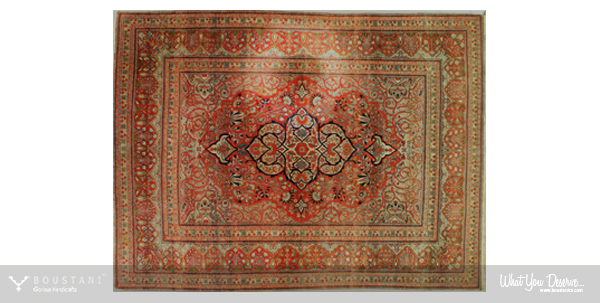Silk is not ideally suited for floor covering, as the pile becomes matted down and wears poorly, consequently most of the rugs are small enough to be used as wall hangings or other types of coverings, although one will occasionally find a large carpet. The medallion design is not so common in these as in the wool carpets, and frequently one sees variations on the tree-of-life theme.
The wool used in Kashan rugs have always been among the best, and the rugs often show a rich surface sheen. About 1890, expanded international trade brought into Persia European textiles that forces Kashan woolen goods from the market. Until that time Kashan had imported wool from other local cities (even Australian wool processed in Manchester) and had woven fine materials for Persian market. Unable to compete with these imports, the Kashan weavers were left with large stocks of merino wool that had no market. A revival of carpet making was in order, and the industry expanded at a spectacular rate, also including the nearby villagers.

Merino wool continued to be imported for Kashan carpets until the early 1930s, when the international depression adversely affected the rug market. Therefore selected wools were purchased from Isfahan, Sabzevar and Kermanshah; after 1940 the final processing was taken over by local mills. The quality of the wool is still superb, although many regard the merino carpets as superior. The early designs, however, were crude in comparison to the later work. This soon gave way to styles suggestive of the Kerman traditional, with naturalistic floral medallion designs. The field, though sometimes open, has usually been covered, with the ground color in bright madder red or less commonly indigo. Some pieces with a cream ground are also found. Since World War II many Kashan rugs have shown strong Safavid influences like the modern Isfahan rugs. Still the designers demonstrate less imagination than in other weaving centers, and one finds hundreds of Kashan rugs in the same limited number of designs. Particularly common is the small lozenge-shaped medallion on a red field, produced in all sizes and grades with remarkably little variation from one rug to the next.

Work in Kashan is carried out in the homes rather than in factories, with each house having a pair of looms working from the same pattern. The weaving is done almost exclusively by women. Rugs of Kashan are generally high-quality, many incorporating silk into their designs. Warp of these carpets are made of cotton however some of the most antique, glorious specimens can be pure silk and the wefts are often dyed blue. The count of knots per square inch (KPSI) can range from 100 to over 800 for the finest examples with the traditional Persian weaving technique means asymmetrical knot.

Mohtasham was one of the most praised master weavers of Kashan who added an honored chapter to the Persian rug history during the last decades of the 19th century. Rugs of legendary Mohtasham are still among the most highly valued Persian weavings across the world.

